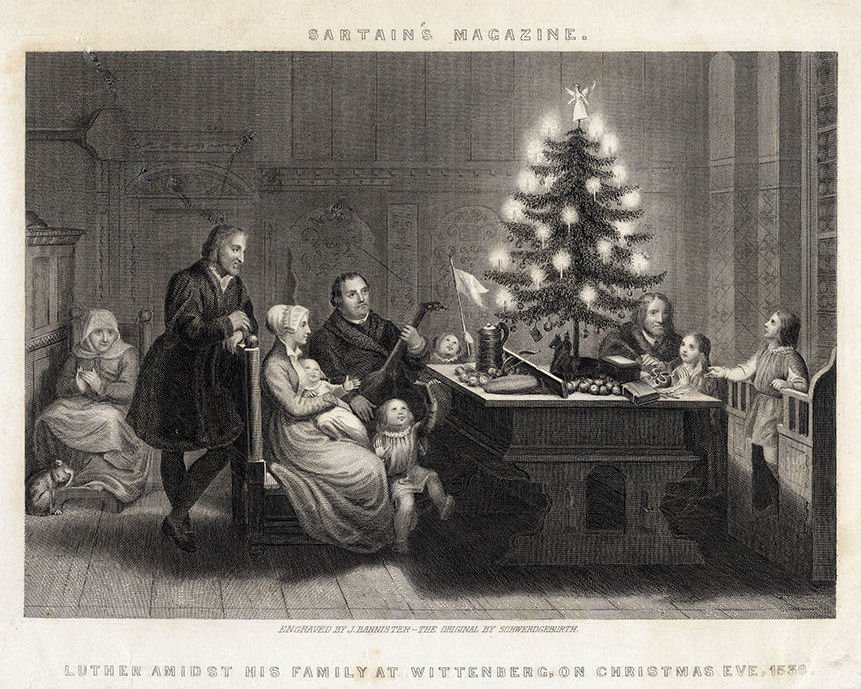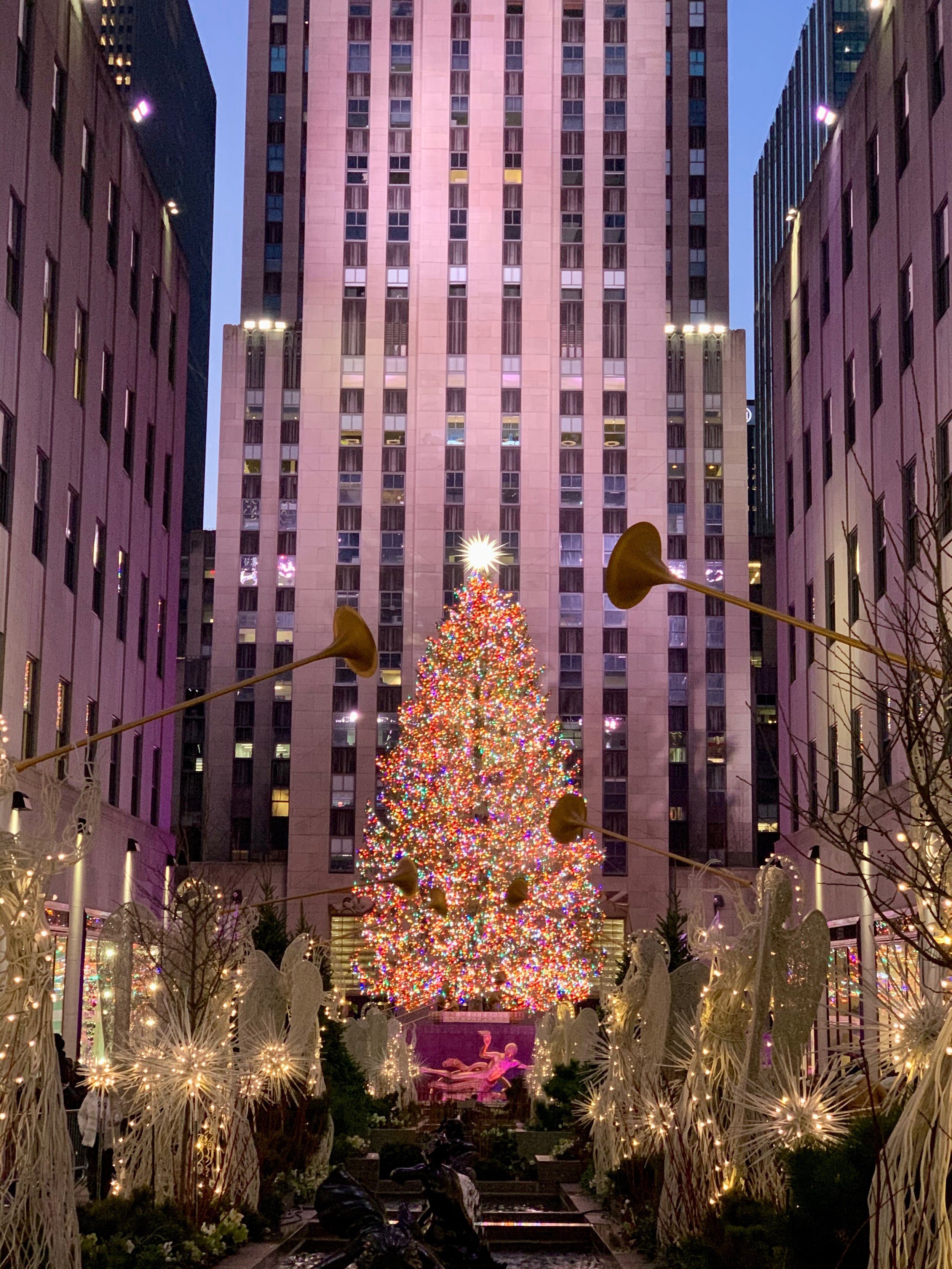The Christmas Tree Isn’t as Pagan as You Think
Happy Christmas, 1891, Viggo Johansen, Hirschsprung Collection, Copenhagen, Denmark
By Heather Bolen
The Christmas tree, an enduring symbol of holiday cheer and festivity, has a fascinating history that spans centuries and cultures. While it shares echoes of ancient traditions that honored nature and seasonal renewal—leading some to call it pagan—it emerged independently as a Christian symbol, blending religious and cultural practices into a cherished part of modern Christmas celebrations.
Egyptian Seasonal Traditions: Palms as Symbols of Life
In ancient Egypt, the winter solstice marked a time to celebrate the triumph of life over death. Egyptians honored the god Ra, who was believed to recover his strength during this period, using green palm rushes and papyrus reeds as symbols of renewal and life. These palms were not used as domestic decorations in the way modern Christmas trees are, but their symbolic associations with eternal life and hope hint at humanity’s enduring reverence for greenery during the darkest time of the year.
The Theban Tomb of Roy in Dra' Abu el-Naga, Luxor, features ancient Egyptian wall paintings where greenery, symbolizing rebirth and eternal life, is depicted as part of funerary offerings for Roy, a royal scribe, and his wife, Taweret. Image Credit: World History Archive / Alamy Stock Photo
Ancient Echoes: Evergreen Symbols of Life
In Northern Europe, long before the advent of Christianity, evergreen plants held special meaning for various civilizations. Druids and other pagan groups revered evergreen trees as symbols of eternal life. During the harsh winters, these vibrant trees served as reminders of nature’s resilience and the promise of spring. Early Germanic tribes are believed to have brought evergreens into their homes during their midwinter celebrations.
Roman Traditions: Evergreens and Saturnalia
The Romans also celebrated the winter solstice with greenery. During Saturnalia, a festival honoring Saturn, the god of agriculture, they adorned their temples and homes with evergreen boughs. These decorations symbolized renewal and the continuity of life through the darkest part of the year, aligning with their agricultural and seasonal beliefs. Originally a one-day event on December 17, Saturnalia was later expanded to a week-long celebration from December 17–23.
In Rome, the Saturnalia holiday was kicked off with a religious ceremony in the Temple of Saturn, followed by a free public banquet open to all. Businesses and law courts were closed so everyone could take part. Image Credit: Getty Images
Christian Adaptation: The First Christmas Trees
The modern Christmas tree—distinctly Christian in origin—is most closely associated with Germany. By the 16th century, devout Christians in the region began bringing evergreen trees into their homes, adorning them with apples, nuts, and candles. Pyramid-shaped wooden stacks were sometimes used in place of trees during lean times, maintaining the festive spirit with whatever was available.
One popular legend credits the Protestant reformer Martin Luther with the first lighted Christmas tree. It is said that Luther was inspired by the beauty of starlight shining through the trees one winter evening and sought to recreate the effect by placing candles on a tree inside his home. However, it is highly unlikely that Martin Luther had any connection to Christmas trees. His letters, Table Talk, and the biographies written by his contemporaries make no reference to such a tradition. The widespread belief linking Luther to the Christmas tree seems to stem from an 1843 engraving by Carl August Schwerdgeburth, which depicts the Luther family gathered around a tree. 19th-century depictions of Luther's domestic life often incorporated elements common to their own era, such as the Christmas tree, which had become a well-established part of German holiday celebrations by the 1840s—but not during Luther's time in the 16th century.
Carl August Schwerdgeburth’s 1843 imaginary engraving of Martin Luther and his family for Sartain’s Magazine, published 300 years after Martin Luther, was widely reproduced and much imitated. No doubt the growing visual association of Luther with an anachronistic Christmas tree led to the story that he invented the tradition. Image Source: Public Domain via WikiCommons
The Spread of the Christmas Tree Across Europe
By the 18th century, the tradition of Christmas trees spread beyond Germany, thanks to German immigrants and royal connections. One of the most significant moments came in the late eighteenth century when Queen Charlotte, the German wife of King George III of England, introduced her native holiday customs to the British court. In 1880, the Queen famously set up a yew tree at Windsor Castle for a children’s Christmas party. The tree was decorated with candles, fruits, and small gifts, following the German tradition she grew up with. This marked the first recorded use of a Christmas tree in England, though it was a novelty and primarily confined to royal and aristocratic circles.
It wasn’t until the ascendency of Queen Victoria and Prince Albert, who popularized the custom after an engraving of their family around a decorated tree appeared in a widely circulated publication in 1848. This image inspired households across Britain and the United States to adopt the tradition.
Queen Victoria and Prince Albert Christmas Tree at Windsor Castle, December 1848, drawn by Joseph Lionel Williams for The Illustrated London News.
The Christmas Tree in America
Although the Christmas tree has roots in Christianity, many Americans were initially resistant to adopting the tradition, associating it with pagan customs. The practice largely remained confined to Germany until the late 18th and early 19th centuries. During this time, the Puritans in New England maintained particularly stringent views on Christmas, enforcing severe punishments for any celebration or decoration. They believed the holiday was so sacred that it should only be observed through church services.
This somber approach to Christmas persisted in America until the late 18th century, when German communities, especially those in Pennsylvania, began decorating communal Christmas trees. Before long, these trees also appeared in the homes of individual German families. However, much of the broader American population remained hesitant about the tradition. The turning point came in 1848 with the appearance of the image of England's Queen Victoria and Prince Albert standing with their family around a decorated Christmas tree. This image played a key role in popularizing the custom across the country.
“O Christmas Tree”
The carol "O Christmas Tree" originated in Germany as "O Tannenbaum," with "Tannenbaum" meaning "fir tree," not specifically "Christmas tree." The original song was a folk tune celebrating the evergreen tree’s beauty and resilience without connection to Christmas. 1824 German composer Ernst Anschütz revised the lyrics, using the tree as a metaphor for loyalty and faithfulness. When the song was later translated into English in the 19th century, it was mistakenly titled "O Christmas Tree" because of the tradition of decorating evergreen trees for Christmas. However, some English versions still use "Tannenbaum," honoring the carol’s German origins.
The Christmas Tree, 1911, Albert Chevallier Tayler, Private Collection
Modern Innovations: Tree Lights, Ornaments, and Commercialization
The invention of electric lights in the late 19th century revolutionized the Christmas tree. In 1882, Edward H. Johnson, an associate of Thomas Edison, created the first electrically illuminated Christmas tree, paving the way for the dazzling displays we see today. Glass ornaments, first crafted in Germany, also became popular, and families often crafted their own ornaments using simple materials. Strings of popcorn, cranberries, and paper chains were popular choices for garlands, adding a handmade charm to Christmas trees that reflected the traditions and creativity of the season.
In the early-to-mid 1900s, Shiny Brite ornaments emerged as a defining feature of the U.S. Christmas tree tradition. Inspired by imported German glass ornaments, Shiny Brite marked the beginning of the American ornament industry, offering brightly colored and affordable decorations that became household staples during the holiday season.
The tradition of public Christmas trees also gained traction during this period. The lighting of the Rockefeller Center Christmas Tree in New York City, which began in 1933, remains an iconic annual event that draws visitors from around the world.
Rockefeller Center Christmas Tree. Image Source: Heather Bolen, Travel & Culture Salon
Environmental Impact and Sustainability
The environmental impact of Christmas trees depends on your choice between real and artificial. Real trees, grown on farms, absorb carbon dioxide as they grow and are biodegradable. They can also be recycled into mulch or composted, making them an eco-friendly option when sourced locally and sustainably. However, their cultivation requires land, water, and resources; transportation emissions can add to their footprint. Artificial trees, made from non-biodegradable plastics like PVC, have a higher carbon footprint during production and shipping, especially if imported. While they can be reused for many years, they eventually end up in landfills, taking centuries to decompose.
To minimize environmental impact, opt for a locally sourced real tree and ensure it is composted or recycled after use. If choosing artificial, commit to using it for at least 7–10 years to offset its production impact. Both options can be sustainable with mindful practices, such as using energy-efficient decorations and recycling whenever possible.
The Christmas Tree Today: A Global Icon
The Christmas tree, as we know it today, is a distinctly modern tradition rooted in the practices of 18th-century German Lutherans, particularly among the upper classes. While greenery has long been used in winter celebrations, the Christmas tree itself is not a pagan symbol. Instead, it reflects a Christian reinterpretation of seasonal customs, with decorated trees first appearing in Germany as part of festive Christian celebrations. Early trees were often fir or yew, though wooden pyramids or deciduous branches were also used in some areas.
By the 19th century, the Christmas tree had spread beyond Germany, thanks to royal influence and its association with joy and togetherness. Today, it is a global holiday icon, adapted across cultures to bring light and warmth to homes and public spaces during the holiday season.











